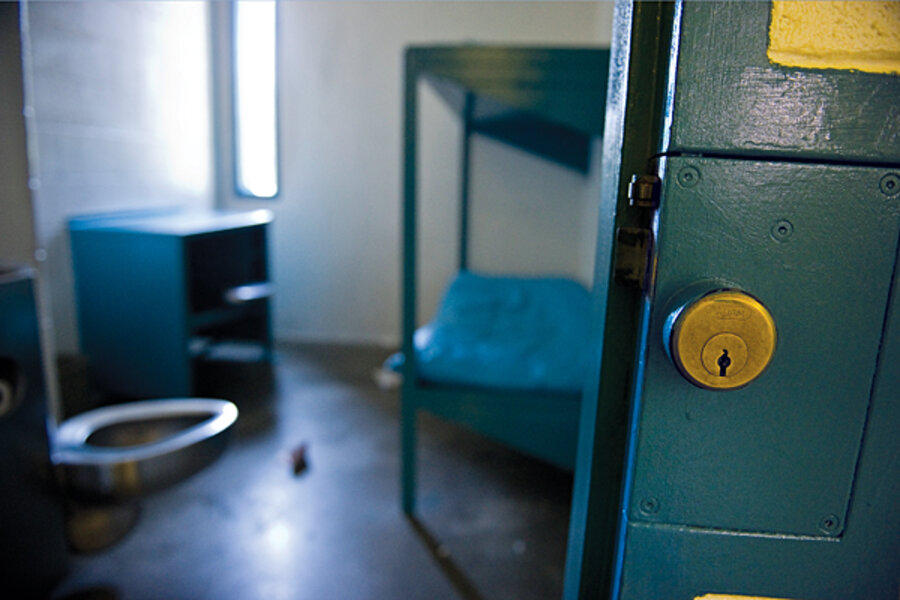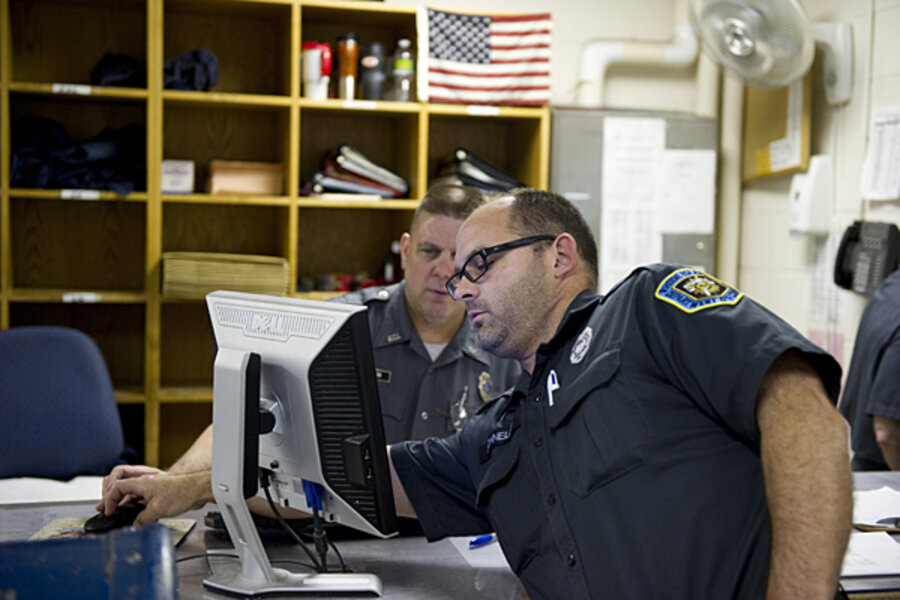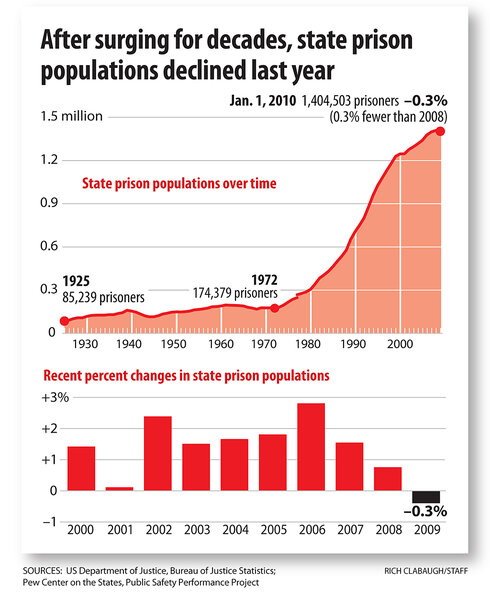Emptier prisons: Inmate population drops for first time in 40 years
Loading...
| Cranston, R.I.
Three years ago, Rhode Island's prisons were straining to house the state's booming inmate population. With cells overflowing and bed space maxed out, dozens of inmates were being housed in holding cells, Spartan quarters designed to hold prisoners for a few days.
Some inmates lived in these holding cells for days on end, sleeping on mattresses on the floor, awaiting trips to other modules for showering and using the toilet. This, even after the state launched a massive and expensive construction campaign designed to solve prior overcrowding problems.
Today, most of those holding cells are empty, and entire blocks of cells have been closed off for months at a time in the Intake Service Center, the state's jail.
After peaking at about 4,000 inmates in late 2007, Rhode Island's prison population is now around 3,300. It's an improbable position for the state, whose prison population was projected to grow another 25 percent in the coming decade.
"The change has been dramatic," says A.T. Wall, director of the Rhode Island Department of Corrections. "The staff is less harried … there's a sense that we're in charge, a general feeling that things are calmer, more orderly."
After surging for decades, the number of state prisoners in the United States has declined for the first time in nearly 40 years, according to the Pew Center on the States in Washington. As of Jan. 1, state prisons across the country held 1,404,053 people – 4,777 fewer than a year ago.
Driven by budget crises, many states have pursued alternative strategies to reduce their prison populations. Among them are moves to divert low-level offenders and probation and parole violators from prison and to accelerate the release of inmates who complete risk-reduction programs.
"More and more policymakers are realizing that new technologies and strategies are more effective and less expensive than warehousing somebody in a $30,000-a-year taxpayer-funded prison cell," says Adam Gelb, director of the public safety performance project of the Pew Center on the States.
Of the 26 states whose prison populations fell, Rhode Island had the largest drop – 9.2 percent between 2008 and 2009.
Rhode Island policymakers worked with the Pew Center and the US Justice Department to outline three policies to reduce prison spending. The state spends an average of $40,000 per inmate, per year.
The first policy cuts an inmate's sentence – by as much as 10 days per month – for following institution rules.
Another further trims sentences for inmates participating in programs designed to reduce recidivism, such as job training and anger management.
Also, criteria used to determine how likely an offender is to reoffend is part of deciding parole.
The results were immediate, says Mr. Wall.
The average population of the prison dropped by 87 prisoners from the previous year, and 81 percent of the 4,278 people who completed prison terms during fiscal year 2009 had their sentences reduced by the new earned-time laws.
"We've probably resolved [overcrowding] for the foreseeable future," Wall says.
Like Rhode Island, states across the country are fighting decades of explosive growth in their prison populations.
Fueled by stiffer sentencing and release laws, prison populations rose precipitously starting in the early 1970s. The war on drugs and zero-tolerance laws on crime sent the prison population soaring in the 1980s and '90s.
Between 1925 (the first year national prison statistics were collected) and 1972, the prison population increased by 105 percent.
In the nearly four decades since then, the prison population grew by 705 percent, according to the Bureau of Justice Statistics. Today, about 1 in 100 adults in the US lives behind bars. The Pew report findings mark the first dip in the state prison population since 1972.
"Is this a tap of the brakes or a shift into reverse?" asks Mr. Gelb, of the Pew Center. "It's too soon to tell, but we think there's several reasons [behind the drop]."
At the top of the list is money.
Over the past two decades, corrections spending has jumped from $11 billion to more than $50 billion. It's the second-fastest-growing state budget category behind Medicaid.
"There's not a warden [who] wouldn't tell you that these costs … are bankrupting them," says Ted Kirkpatrick, codirector of Justiceworks, a crime and justice research group at the University of New Hampshire in Durham.
Some states, such as California, plan to release inmates before their sentences are complete.
Meanwhile, crime and arrest rates have been declining in the past few years, easing the pressure on state prisons. In fact, crime in all categories was down last year, according to the latest FBI figures.
Underlying these reasons, however, is a significant shift in attitude and in policy.
"The common story is the fiscal budget," says Marc Mauer, executive director of the Sentencing Project, a prison reform advocacy group. "But it's deeper than that, too. The climate has definitely shifted over the last decade ... and it's very much a bipartisan movement."
The faith community's support for alternatives to incarceration is a factor behind the shift in outlook, says Mark Earley, president and CEO of Prison Fellowship, a Christian organization pushing for criminal-justice reform.
"The entrance of faith-based groups has made it particularly comfortable for social conservatives to see that a significant part of their grass-roots constituents feels differently about this issue," says Mr. Earley.
"Faith-based groups advocating for change has helped foster bipartisanship [on prison reform]," he says.
As a result, many states are reconsidering criminal-justice policies.
Some states are reducing the fraction of a sentence that must be spent in prison, diverting inmates to probation officers. Others are bypassing incarceration altogether, directing offenders to community supervision programs.
Many states are revising mandatory minimum sentencing laws enacted by Congress in 1986, which force judges to impose fixed sentences regardless of culpability.
The push to reduce prison populations and specifically to release prisoners early, hasn't been without controversy, however. Many worry that public safety will be compromised.
Crime Victims United of California, a nonprofit group, sued the state earlier this year over its efforts to trim its prison population. The group claims that releases driven by overcrowding would violate a 2008 voter initiative – Marsy's Law – that provides all victims with due process.
"It's a major concern to public safety," says Nina Salarno, executive board member at Crime Victims United of California. Many states are letting out prisoners with little or no rehabilitation due to budget cuts, says Ms. Salarno, whose sister was a victim of crime. "There's some very serious people [who] are going to be let out."
Incarceration is expensive, she acknowledges. "But what we have to pay is significantly outweighed by potential harm to society. We can't put a price to that."
The risk to public safety is real, says Wall, director of the Rhode Island prisons where early releases helped dramatically shrink the prison population.
"We are dealing with risk assessment for human beings, it can never be fail-safe," he says. But incarceration comes at a heavy cost to society as well, he adds.
"There are hidden trade-offs there," says Wall. "The costs that accumulate down the years, they have an impact, too, on funding for education, for health programs, for tax rates."
"And while that can't be captured with the same impact or force that a horrible crime [can]," he says, "the fact is, that has an impact, too."
Related:








